
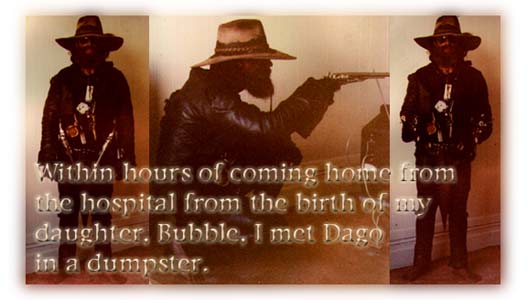
A PERSONAL HYSTERY OF THE MOUNTAIN BIKE
. . . from wooden wheels and mustaches to bananas and flannel to Red Bull and baggies . . . from Missoula to Saint Louis on a 50 pound singlespeed to over Pearl Pass on a geared klunker to "Look at me, Mommy," ---this is a personal hystery of the mountain bike
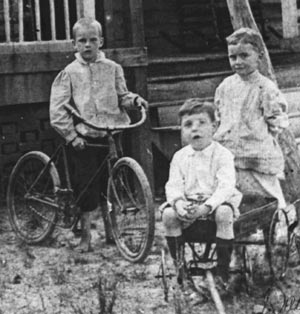 I have a picture of my grandfather taken in 1906 when he was eight years old, standing beside a stripped down Spalding safety bike, every part not for "whoa" or "go" had been removed for light weight. In the early fifties we called these wonders "clunkers" or "klunkers," when they were chopped for the dirt, and "cruisers," when they were clean stock or duded for the street.
I have a picture of my grandfather taken in 1906 when he was eight years old, standing beside a stripped down Spalding safety bike, every part not for "whoa" or "go" had been removed for light weight. In the early fifties we called these wonders "clunkers" or "klunkers," when they were chopped for the dirt, and "cruisers," when they were clean stock or duded for the street.
Riding bicycles off-road was a tradition long before I stripped my 1948 Schwinn "step-through" cruiser with 24 inch wheels and clothpinned cards to the seatstays and farted noisily through the neighborhood, along the borders of tobacco and corn fields, and through the woods behind our house in rural North Carolina. Whenever I could, I rode my bike with three scraggly negro kids from the south side of town who all owned funky bikes just like mine, stripped-down and rusty.
My most memorable rides, however, were those I did alone with my dog, through pine forests, farmlands and back alleys of the old town of Goldboro, North Carolina. I used my bike as an archeological exploration vehicle, discovering Indian mounds, ancient carved stone tablets, and grave sites from the Civil War era. I visited remote clearwater swamps with white sandy bottoms, encountered frogs, foxes, an endless variety of snakes and bugs, red and white mushrooms, and a stash of pornography in collapsed barn. Except for the real danger of inbred redneck pedophiles, the flatland woods and fields were safe terrain for a young boy on a stripped-down Schwinn.
That was 1957.
ALL TERRAIN BICYCLE CHRONOLOGY
I got most of this stuff from the Christian Science Monitor's website. Tell your kids. Save money on an encyclopedia.
1817. The sport of riding bicycles in the dirt officially began when Baron von Drais invented the Draisienne, a board between two wooden wheels for Germans to careen out of control through horse shit and mud on the farm and in the city.
1839. A Scottish blacksmith connected a crank mechanism to the rear wheel with two articulated rods, creating the first self-propelled bicycle.
1870. Englishman James Starley invented the high wheeler, or penny farthing, also known as the "ordinary" bicycle, that funny-looking contraption with the huge front wheel and dude with the mustache. This contraption, still a cult favorite to the most insane of our numbers, introduced serious head and shoulder injury to a population with no concept of helmet use outside of warfare.
1884. Englishman H.J. Larson created a bicycle with same-sized wheels, a chain and gears, workable brakes and handling characteristics, and called it the "Safety Bicycle" in obvious comparison to the penny farthing. Sadly for Larson, the bike never caught on.
1885. The nephew of penny farthing inventor stole Larson's idea, called it the "Rover" Safety bike, and cashed in. Larson faded, pennyfarthingless, into his footnote in history.
1887. Former slaves enlisted in the all black United States Army 25th Infantry Bicycle Corps, rode singlespeed Spalding safety bikes from Missoula, Montana to St. Louis, falling into the trend where descendants of slaves do more-than-equal things just for the CHANCE to be considered equal.
1940. Japanese mountain bikers invade and conquer Burma, running out the English troops and command staff with bicycle-supported jungle warfare techniques.
1945. The nuclear bombs dropped on Hiroshima and Nagasaki kill more bicyclists than enemy troops.
WHEELMEN TO REAL MEN
At the turn of the 20th century organized groups of enthusiasts called "wheelmen" created a cult of the bicycle. Home spun ingenuity focused on human-powered travel in blacksmith shops and barns throughout the U.S. and Europe. Wheelmen hot-rodded high wheelers and safety bikes, raced them, sold them, stole each others' ideas, made them better. The bicycle was used to market cereals and tobacco products. Many brake and suspension technologies in use today have roots at the turn of the century when there was no such thing as pavement, and regular folks either had a bike, a horse, or they fucking walked.
Soon the motorcycle and the automobile killed the rush of bicycle technology at the beginning of the 20th century. Boys stopped riding cruisers when the balls dropped and a driver's license was in hand. Sadly, the bicycle came to be seen as a "low-status" symbol. The only grown man I ever saw riding a bike when I was a kid was Fred Benton, a fifty year old man who lived in a cardboard box in the lumber yard and rode around town drunk, cussing noisily at kids like me, carrying two buckets on the handlebars. He smelled like whiskey from a block away as he pedaled around searching for scraps of food or anything to trade for a bottle of cheap liquor.
During this slump in the popularity of the bicycle in America we owe the continuation of the "cult" to kids like me who carried the torch until the age of 16 when we migrated into cars for life, or became like Fred Benton. The wish for a bicycle for Christmas, the courage and daring to fuck it up with a wrench when you got it--this is what maintained the dirt-specific bicycle until a defining moment in the 70's when grown men picked up rusting, discarded cruisers, put an assortment of flea market bicycle parts on them, began riding like the "wheelmen" of old, and ended up on television.
NORTHERN CALIFORNIA NUTS AND FLAKES
In April of 1975 my newly immigrated and very pregnant Belgian wife, Miki, and I moved into the Haight Ashbury of San Francisco, a low rent district in transition from heroin and hippies to queers and yuppies. The neighborhood was a strange mixture of shell-shocked and pitifully handicapped Vietnam veterans, assorted junkies, psychedelic drug crazies, drug dealers, child prostitutes, retarded prostitutes, shameless hedonists, trust fund babies, flamboyant gays, . . . and struggling artists, comedians and musicians, like myself. It was a place where you could wear dirty underwear on your head or tattoo "fuck" in Old English across your forehead and not be noticed on the street.
By the way, I knew people who actually did all of the above.
Days after settling into an apartment on Lyon Street directly across the street from where Janis Joplin and Charlie Manson once lived, I bumped into a friend from Amsterdam who offered me a painting job, saying, "Act gay. Don't tell anyone that you have a wife and a kid. The guys we work for don't like breeders."
For the next few months I hung out high above the street dangling from ladders and scaffolding with a wild bunch of swishing, flaming fags (and proud of it), painting Victorian Gingerbread houses in tacky colors for the upscale infestation of trustfunders and yuppie scum who eventually turned the Haight into a place where you could buy espresso, ice cream, cake and tacky clothes in shops with fancy awnings, but couldn't find a place to do your laundry or buy toilet paper.
Some weeks later I ran into an acquaintance from Chapel Hill, who sold me a wheezing, classic two-tone 1962 Chevy Bel Air convertible for two hundred and seventy five bucks.
Within hours of coming home from the birth of our daughter, Mystery Bubble, I met a fellow who called himself "Dago" in a dumpster. I simply jumped in, and there he was--smiling, dirty, in nothing but a leather loin cloth, looking just like the picture of crucified Jesus that grandma hung over her lounger--only Dago was dirtier, wore less clothing, and had a MUCH nicer smile.
Everything Dago owned was dirty. His family lived in a filthy, smelling '67 T-bird. At first glance you couldn't even SEE his wife and kid in the car. They blended in well with the dirty tools and smudged Playboy pin-ups Dago crammed, velcroed and taped to the roof and windows of the T-Bird. His car, his life, his wife, his kid were impressive, rolling, functional performance art.
One day, soon after our first encounter, Dago arrived at our door, unannounced, barefoot, nearly naked, smelling of B.O. and motor oil. He had an ancient English Dunelt bicycle upgraded and hot-rodded with flea market Campy parts. "Twenty five bucks," was all he said.
So, all toll, within a month of landing in San Fran, I had a baby, an apartment, a car, a job painting houses with the Angels of Light, a strange assortment street-level friends, a smelly, dirty bike with good parts, and the support of an entire neighborhood for any irrational artistic behavior I chose to pursue.
One evening in 1978 (or 79) there was a feature on Channel 5's "Evening Magazine" documenting a wild bicycle race on Mt. Tamalpias just north of the city. A bunch of longhaired wildmen in jeans and open flannel shirts with bananas sticking out of their pockets were blasting down a narrow fire road on cruiser bikes, tossing rooster tails of dust into the air as they slid sideways through tight S-turns. I laughed uncontrollably as rider after rider slipped, flipped and crashed into trees bordering the road.
I thought, "I remember this shit. I stopped doing it when I got a car."
This perfectly stupid event, called Repack, if you haven't heard the boring story, was so named because during the downhill run riders heated rear crusier brake hubs so hot that the grease ran out like water. Each rider had to "re-pack" their coaster brake hub bearings after each run.
The very next day, inspired by the fruits, nuts and flakes in denim and flannel on television, I took my funky custom ten-speed Dunelt onto a Golden Gate Park singletrack, and on a tight off-camber whoop-tee-do turn through a grove of trees, I rolled the front tire off of the rim and bashed my nuts into the stem.
I gave the Dunelt to a drunk in the park and went on a sustained search for an old cruiser like the one I had as a kid. I soon found a 1947 Schwinn "step-in" (used to be called a "girl's bike") in a Pacific Heights dumpster. Later I found a Japanese cruiser copy and put low -rise braced motorcycle racing bars on it. I traded a trick skateboard for an early Redline BMX racing frame and put a six speed on it for our daughter, Bubble. With Dago, the dirty Thunderbird dweller, and Tosh Alcala, an early pro skateboarder, Miki and I began a long standing tradition of riding Golden Gate park nearly every day. On Sundays we headed across the Golden Gate into the Marin Headlands. We were most likely the first to ride singletrack in Golden Gate Park, around Lands End, the Presidio and the Golden Gate Recreation Area. We were certainly the first true urban "freeriders" in Frisco, railing the downtown parking garages where hookers blew their clients in the shadows as our tires squealed around the slick ramps. We trashed all of the city's golf courses where lawyer's putts were never the same.
A ripple effect from the Repack race soon sent prices of old Columbia and Schwinn Excelsior frames to well over $300 within weeks of the televised news coverage. Rumors that a few local road bike frame builders were making off-road bicycles from scratch echoed through the flea markets within months.
The dam was about to burst.

Copyright Dreamride LLC. No material, written, graphics, or photographs on this website, may be reproduced, broadcast, published, re-written, re-edited, or re-used in any way outside of this site without written consent of Dreamride LLC and Lee Bridgers. Use of this site signifies agreement to terms of use.
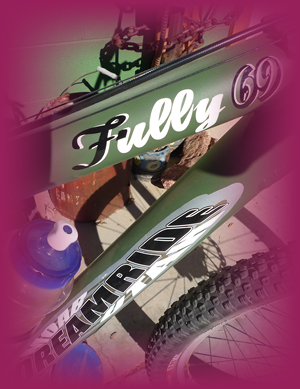 The Dreamride Contribution
The Dreamride Contribution
If there is a piece of equipment that Dreamride offers that is truly a contribution, it is the Dreamride Fully69 (F-69), a colaborative effort with Ventana, combining the best 4 bar rear suspension design with our own geometry, componentry and a 29 inch front wheel. This is the best mountain bike for rough terrain we have ever ridden or offered.

A Testimonial:
"The bike is quick, incredibly balanced and drop dead gorgeous. I have been a titanium junky (Lightspeed) for years but I ain’t ever goin’ back. The Fully is sweet, tight and Oh so forgiving without being mushy or inaccurate; you point it and it goes where you want it to; you CAN thread the obstacles but if you want to go over them; go and it laughs out loud! (Or maybe that was me that was laughing). The weight was what I was the most worried about prior to my first ride but it is clear now that movement forward is impeded by vertical movement and the Fully so effectively mitigates the vertical that the small weight penalty is more than offset. This bike feels friggin’ light." ~ Mike Simmons, Taos, New Mexico
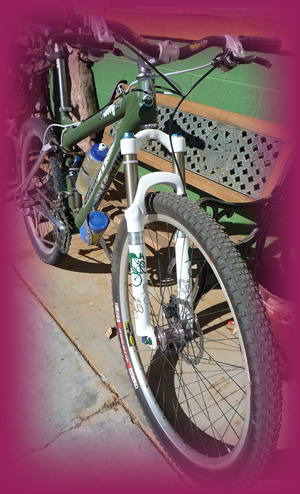 Call toll free 1-888-MOABUTAH right now to get your Fully order underway.
Call toll free 1-888-MOABUTAH right now to get your Fully order underway.
If you want more information on parts, design, Moab vacation combinations or special invitational trips for Fully purchasers, EMAIL or call 1-435-259-6419. Call the same number in Moab, Utah for an appointment at our private shop. It is best to make appointments at least a week in advance during peak season months.
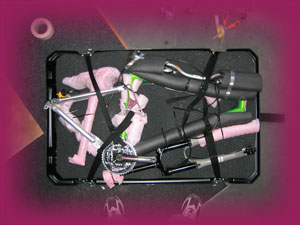 Each and every Dreamride Fully comes in a hardshell flight case.
Each and every Dreamride Fully comes in a hardshell flight case.
Every bike is carefully packed into a Serfas case. We anticipate rough handling in transit with foam tubing, strapping and careful placement. The Serfas case is sized to fit within reasonable shipping-rate categories. Lockable steel latches for security. Wheels and hand-strap for transport through airports. Pictures of your bike carefully packed in the case are posted along with maintenance and reassembly info on your personal webpage.
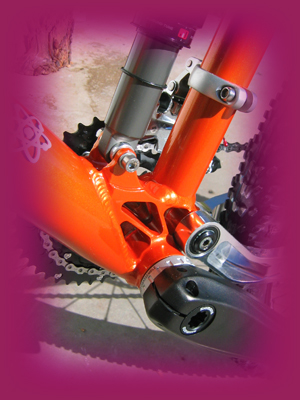 Combine your Fully or F-69 purchase with a Moab mountain bike vacation.
Combine your Fully or F-69 purchase with a Moab mountain bike vacation.
Dreamride offers a special vacation package for those purchasing a Dreamride bike. The package includes many personal touches such as complete privacy for a single client, special lodging deals and guiding by Lee Bridgers, company owner and Fully designer and builder. Click on THE PACKAGE for info.